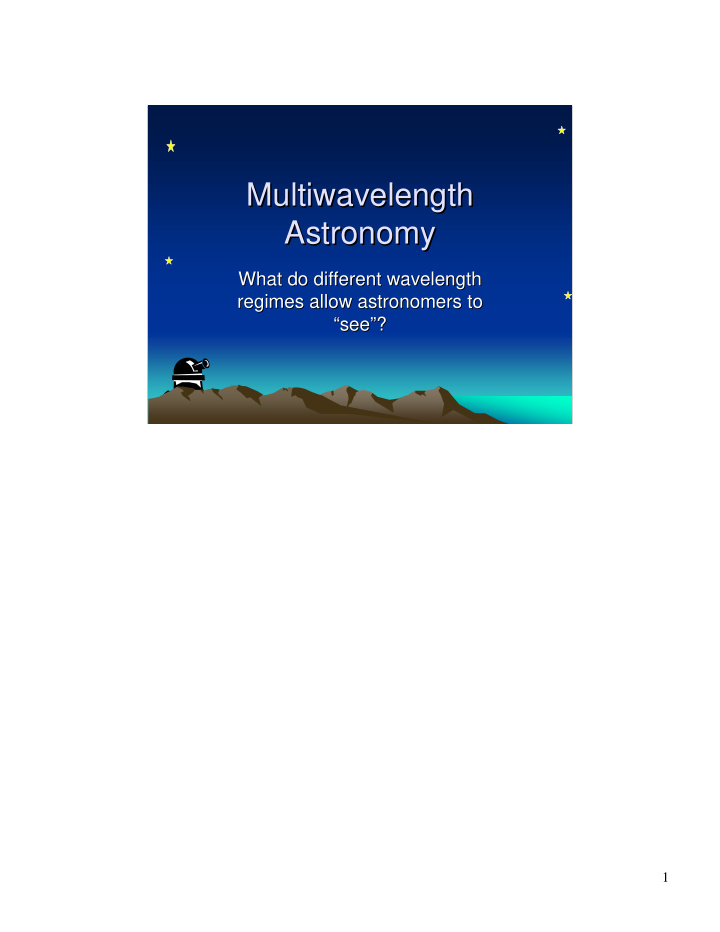



Multiwavelength Multiwavelength Astronomy Astronomy What do different wavelength What do different wavelength regimes allow astronomers to regimes allow astronomers to “see see” ”? ? “ 1
Temperature vs. peak Temperature vs. peak wavelength wavelength ) V s U t ) s h R e e ( g v I v t ( a e i L a d w s l w o e e y o i r o l a v b a i r a d R r i c r s f a i n X t M i R l V I U 10 -9 m 1 micron 100 microns 1 cm 1 m Increasing wavelength 5x10 6 K 5000 K 50 K 0.5 K Increasing temperature • Recall Wien’s Law: object’s temperature determines the wavelength at which most of its electromagnetic radiation emerges Electromagnetic radiation is everywhere around us. It is the light that we see, it is the heat that we feel, it is the UV rays that gives us sunburn, and it is the radio waves that transmit signals for radio and TVs. EM radiation can propagate through vacuum since it doesn’t need any medium to travel in, unlike sound. The speed of light through vacuum is constant through out the universe, and is measured at 3x10 8 meters per second, fast enough to circle around the earth 7.5 times in 1 second. Its properties demonstrate both wave-like nature (like interference) and particle-like nature (like photo-electric effect.) 2
A temperature- -dependent dependent A temperature “hierarchy hierarchy” ” of states of matter of states of matter “ • Coldest (T < 100K) – dense molecular gas, ice-coated dust • “Warm” (100K ≤ T ≤ 1000K) – warm dust & molecules • Hotter: (1000K ≤ T ≤ 10000 K) – atomic gas (molecular bonds break down) • Hotter still: (T > 10,000K) – ionized gas (electrons separated from nuclei ⇒ plasma ) 3
Radio/Microwave Radiation Radio/Microwave Radiation • Long λ • Very penetrating – most matter is transparent to radio waves • Probe of “coldest” matter (dense gas & dust) – Afterglow of “Big Bang” (T ≈ 2.7 K) • Probe of molecular gas – Many molecules were first detected in interstellar space via their radio radiation • carbon monoxide, water, hydrogen cyanide, ammonia, alcohol… 4
Mid- - to Far to Far- -Infrared Radiation Infrared Radiation Mid • Very “penetrating,” e.g., through dust and gas • Probe of “dust grains” – huge variety known, from giant molecules to grains of glass • Most of known dust in universe emits in mid- to far-IR – Dust forms around dying stars – Dust congeals into planetary systems now forming around young, recently formed stars – Dust surrounds the massive centers of many galaxies • Planets emit most strongly in mid- to far-IR wavelengths 5
M17 Star Cluster: M17 Star Cluster: Combination of Visible and Far Combination of Visible and Far Infrared Image Image Infrared 6
Near- -infrared radiation infrared radiation Near • Probe of “hot” dust and molecular gas • Somewhat penetrating – λ = 2 µ m penetrates matter 10 times as far as visible light • Probe of stars that are cool and/or surrounded by dust clouds – e.g., stars that have just formed and stars that are “kicking off” (starting to emit light) 7
Visible Near- -Infrared Infrared Visible Near 8
Hot molecules and dust Hot molecules and dust Image mosaic of the NGC 6334 star formation region obtained with SPIREX/Abu telescope at the South Pole 9
Visible light Visible light • Easily scattered by dust clouds • Visible-light universe dominated by stars – Starlight can be detected directly (the stars themselves) or reflects from dust grains near stars – Stars are a primary constituent of galaxies, so distant galaxies are usually first detected in visible or near-IR light • Gas ionized by UV from hot stars (and heated to about 10,000 K) also emits brightly in visible light – e.g., Great Nebula in Orion (M42) 10
Our Nearest (Galactic) Neighbor in visible light: a twin to the Milky Way? M31 Andromeda Galaxy, Visible Light 11
Ultraviolet Light Ultraviolet Light • Short λ , easily scattered by atomic gas and by dust clouds • Probe of hottest stars and ionized gas – Matter spiraling into massive objects (collapsed stars or centers of massive galaxies) emits strongly in the UV as it gets heated to T>10000 K 12
X Rays X Rays • Highly energetic photons ⇒ highly penetrating – dust is nearly transparent to X rays • Probe of cosmic “collisions” that produce plasma with T > 1,000,000 K – e.g, gas ejected at high speed from rapidly dying stars collides with gas that was ejected earlier and at lower velocity by same star ⇒ gas heated to X-ray-emitting temperatures – Most stars, especially young stars, have tenuous outer atmospheres ( corona ) that is sufficiently hot to emit X-rays – Many compact, massive objects thought to be black holes display X-ray emission 13
X Rays Indicate Explosive Events Supernova remnant Cassiopeia A 14
Supernova Remnant Casseopeia Casseopeia A A Supernova Remnant X ray Infrared Visible Radio 15
A Noisy “Neighbor” Galaxy “Starburst” Galaxy M82 in Ursa Major 16
Images at Many Wavelengths are Needed to Find Newborn Stars Infrared X Ray Central Region of M42 ( Orion Nebula ) 17
Exploding Sun-like Stars Planetary Nebula BD +30 3639 Visible Infrared X Ray (Hubble Space Telescope) (Gemini 8-meter telescope) (Chandra) 18
New Discoveries of X Rays from Planetary Nebulae NGC 6543 (The Cat’s Eye Nebula) NGC 7027 Visible (HST) X Ray (Chandra) 19
Recommend
More recommend